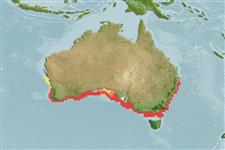Environment: milieu / climate zone / depth range / distribution range
पारिस्थितिकी
समुद्री बेनथोपिलाजिक; गहराई सीमा 60 - ? m (Ref. 9002). Subtropical
Indian Ocean: Australia.
आकार / वज़न / Age
Maturity: Lm ? range ? - ? cm
Max length : 40.0 cm TL पुल्लिंग / अलिंग; (Ref. 9002)
Short description
पहचान कुंजी | आकृति विज्ञान | मौरफोमैटरिक्स
पृष्ठीय रीढ़ (सम्पूर्ण) : 9; पृष्ठीय सौफट रेज़ (सम्पूर्ण) : 12 - 13; गुदा कांटा: 3; ऐनल सौफट रेज़: 13.
Found in coastal bays to offshore reefs, often in loose aggregations (Ref. 9002).
Life cycle and mating behavior
Maturities | पुनरुत्पत्ति | Spawnings | Egg(s) | Fecundities | लार्वा
Oviparous, distinct pairing during breeding (Ref. 205).
Kuiter, R.H., 1993. Coastal fishes of south-eastern Australia. University of Hawaii Press. Honolulu, Hawaii. 437 p. (Ref. 9002)
IUCN Red List Status (Ref. 130435)
Threat to humans
Harmless
Human uses
साधन
Special reports
Download XML
इंटरनेट स्रोत
Estimates based on models
Preferred temperature (Ref.
123201): 15 - 19.7, mean 17 °C (based on 6 cells).
Phylogenetic diversity index (Ref.
82804): PD
50 = 1.0000 [Uniqueness, from 0.5 = low to 2.0 = high].
Bayesian length-weight: a=0.00501 (0.00207 - 0.01214), b=3.15 (2.94 - 3.36), in cm total length, based on LWR estimates for this (Sub)family-body shape (Ref.
93245).
Trophic level (Ref.
69278): 3.5 ±0.37 se; based on food items.
Generation time: 4.1 ( na - na) years. Estimated as median ln(3)/K based on 2
growth studies.
लौटाव (Ref.
120179): माध्यम, न्यूनतम जनसंख्या दुगनी होने का समय 1.4 - 4.4 वर्ष। (Preliminary K or Fecundity.).
Fishing Vulnerability (Ref.
59153): Low to moderate vulnerability (30 of 100).
Nutrients (Ref.
124155): Calcium = 68.2 [36.1, 133.3] mg/100g; Iron = 0.797 [0.420, 1.670] mg/100g; Protein = 17.5 [14.6, 19.5] %; Omega3 = 0.212 [0.112, 0.391] g/100g; Selenium = 28.6 [13.9, 62.8] μg/100g; VitaminA = 21.9 [5.8, 97.3] μg/100g; Zinc = 0.961 [0.632, 1.571] mg/100g (wet weight);
